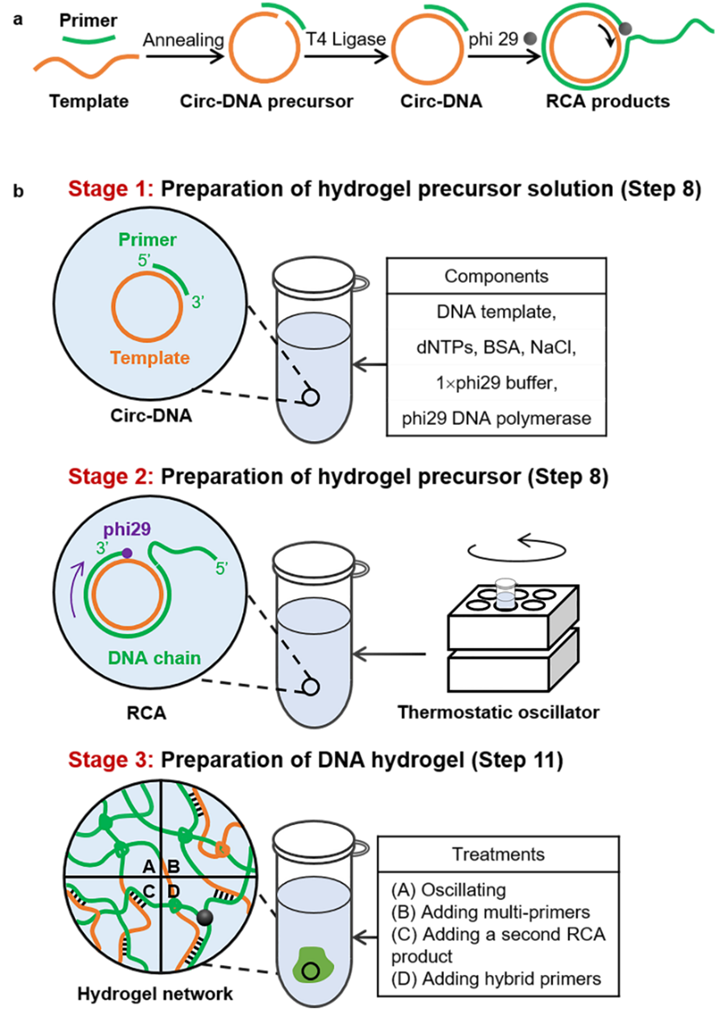Recently, the latest progress in DNA bifunctional materials researched by Yang group in Tianjin University was published onNature Protocols. In this paper, the molecular basis, synthesis strategy, functional regulation and biological applications of DNA hydrogels synthesized by enzymatic rolling circle amplification were systematically reported. This strategy constructed DNA hydrogels with unique physicochemical properties and a variety of biological functions, providing a significant material chemistry basis for cell isolation, cell delivery and disease therapy.
To meet the great demands of life and health, the research on biomaterials with precise and controllable structure and adjustable biological activity is the key and international frontier field for the development of biomedical materials. The creation of key functional matters, including small molecules, macromolecules and cells in life system, involves precise, efficient and mild assembly process catalyzed by bio-enzymes and assembled by biomolecules. As a genetic material, DNA can precisely regulate life activities. From the perspective of material chemistry, as a natural biomacromolecule, DNA possesses the characteristics of sequence programmability and precise transmission of sequence information, and the unique advantages of customizable function and biological activity. Based on the above properties, DNA can be regarded as a building block to precisely create various functional materials. In recent years, DNA hydrogels have emerged in the fields of tissue engineering, disease therapy, protein engineering and soft robotics, and have been considered as a significantly potential biomedical material. DNA molecule in DNA hydrogel is not only the hydrogel framework, but also carries the biological functions of DNA, which can realize the perfect fusion of molecular structure and biological functions.
Yang group launches the systematic research in the field of DNA bifunctional materials. This paper summarized the chemical system of RCA-based DNA hydrogel based on previous works. RCA is a simple and highly efficient isothermal enzymatic amplification strategy to synthesize ultralong single-stranded DNA that benefits from mild reaction conditions, and stability and efficiency in complex biological environments. RCA process is conducted at a constant temperature and requires a small amount of circular DNA template, and the polymerase phi29 catalyzes the elongation and displacement of DNA chains to amplify DNA template at a hundredfold level, which subsequently forms a 3D hydrogel network via various cross-linking strategies, including entanglement of DNA chains, multi-primed chain amplification, hybridization between DNA chains, and hybridization with functional moieties. Firstly, we utilized RCA reaction to produce ultralong single-stranded DNA chains to fabricate physically cross-linking DNA hydrogel via entanglement of DNA chains. And then through controlling the order of reaction time, we achieved multi-primed chain amplification, which performed primary RCA at first and conducted multi-primed reactions using the primary products as the templates. Based on this method, we developed a physically cross-linked DNA hydrogel via the hybridization of ultralong DNA chains to achieve the specific and efficient isolation, 3D envelop and enzyme-triggered release of bone marrow mesenchymal stem cells (BMSCs). We further synthesized a super-soft and super-elastic magnetic hybrid DNA hydrogel via introducing nanofunctional moieties, where magnetic nanoparticles (MNPs) acted as stable cross-links through hybridization to the DNA, and physical entanglement of DNA chains formed dynamic cross-links in the hydrogel network. Through modulating functional moieties, hybrid DNA hydrogel exhibits unique optical and magnetic properties. Based on this synthesis strategy, hybrid DNA hydrogels with ultra-soft, ultra-elastic and magnetic properties were prepared to achieve non-destructive delivery of living cells in a confined space.

Figure 1. | Overview of the protocol for the preparation of RCA-based DNA hydrogels
The original link:https://www.nature.com/articles/s41596-021-00621-2
Yang group takes the biological macromolecular, DNA, as the main line of research, focusing on chemical assembly and intelligent manufacture of DNA bifunctional materials, which are used for life analysis and disease therapy.
The homepage of Yang Group:http://yanglab-dna.com/

By: The School of Chemical Engineering
Editors: Qin Mian & Yang Fan